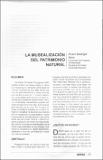| dc.contributor.author | Madrigal Mora, Álvaro | |
| dc.date.accessioned | 2020-11-03T23:34:40Z | |
| dc.date.available | 2020-11-03T23:34:40Z | |
| dc.date.issued | 2004-12 | |
| dc.identifier.issn | 2215-2997 | |
| dc.identifier.other | https://www.revistas.una.ac.cr/index.php/abra/article/view/4206/4051 | |
| dc.identifier.uri | http://hdl.handle.net/11056/18514 | |
| dc.description.abstract | Las Áreas Silvestres Protegidas (ASP) pueden realizar su trabajo desde un enfoque museológico, tomando como punto de inicio la hipótesis de que ellas tienen sus propias particularidades y características que las diferencian de un museo tradicional, y que éstas tienen que ser tomadas en cuenta para establecer hasta dónde y cómo las actividades museísticas pueden ser desarrolladas dentro de ellas. Este análisis está basado en el caso del Sistema de Áreas Silvestres Protegidas de Costa Rica, tratando de aplicar la experiencia obtenida por los museos en su larga tradición como preservadores, investigadores y comunicadores del patrimonio cultural y natural sobre el quehacer y la misión de estas áreas. Así, las ASP son ahora identificadas con la doble responsabilidad de los museos: preservar la integridad del objeto (patrimonioambiente) y, además, participar en el desarrollo de la sociedad. | es_ES |
| dc.description.abstract | Protected Wildlife Areas (ASP) can carry out their work from a museological approach, taking as a starting point the hypothesis that they have their own particularities and characteristics that differentiate them from a traditional museum, and that these have to be taken into account to establish how far and how museum activities can be developed within them. This analysis is based on the case of Costa Rica's System of Wildlife Protected Areas, trying to apply the experience gained by museums in their long tradition as preservers, researchers, and communicators of cultural and natural heritage to the work and mission of these areas. Thus, ASPs are now identified with the double responsibility of museums: preserve the integrity of the object (heritage environment) and, in addition, participate in the development of society. | es_ES |
| dc.description.sponsorship | Universidad Nacional, Costa Rica | es_ES |
| dc.language.iso | spa | es_ES |
| dc.publisher | Editorial de la Universidad Nacional | es_ES |
| dc.rights | Acceso abierto | es_ES |
| dc.rights.uri | http://creativecommons.org/licenses/by-nc-sa/4.0/ | * |
| dc.source | Revista ABRA Vol. 24, No. 33, p. 37-54 | es_ES |
| dc.subject | COSTA RICA | es_ES |
| dc.subject | ÁREAS SILVESTRES | es_ES |
| dc.subject | WILD AREAS | es_ES |
| dc.subject | MUSEOLOGÍA | es_ES |
| dc.subject | MUSEOLOGY | es_ES |
| dc.subject | PATRIMONIO CULTURAL | es_ES |
| dc.subject | PRESERVACIÓN | es_ES |
| dc.subject | CULTURAL HERITAGE | es_ES |
| dc.subject | PRESERVATION | es_ES |
| dc.title | La musealización del patrimonio natural | es_ES |
| dc.type | http://purl.org/coar/resource_type/c_6501 | es_ES |
| dc.description.procedence | Escuela de Sociología | es_ES |


